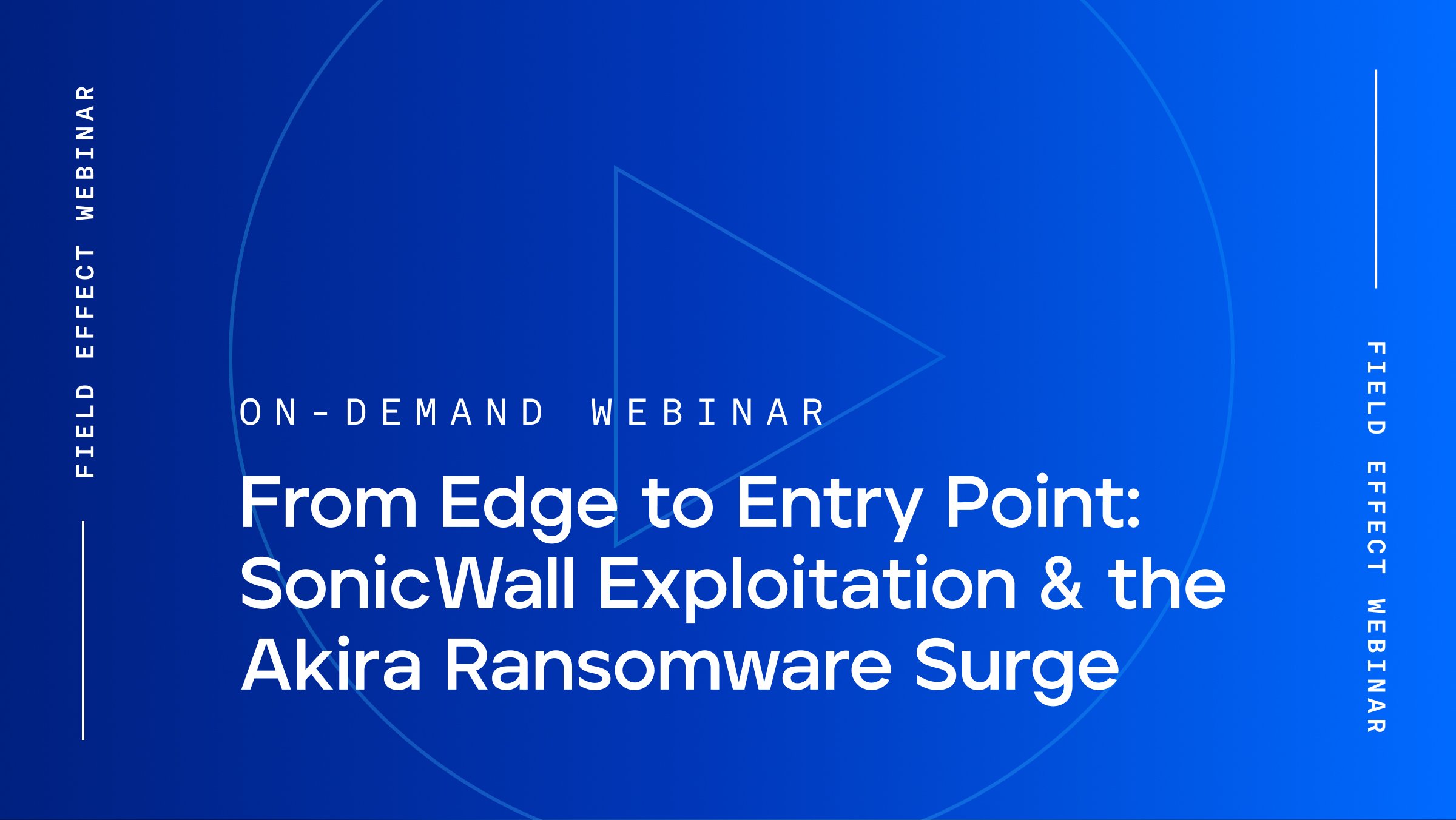
Blog Post
September 11, 2024 | Cybersecurity education
By Field Effect
With contributions from Katie Yahnke and Eric McDonald.
Between malware, ransomware, and advanced persistent threats (APTs), the cyber threat landscape can be intimidating. All three pose a significant risk for businesses everywhere. Defending against these threats is vital, but you need to know what you’re dealing with.
Ransomware alone is common—a report from Verizon shows that ransomware was installed in nearly 70% of breaches in 2022. Yet confusion remains on who these attacks target, the extent of ransomware’s impacts, and how it relates to malware and APTs. With all these threats making waves with greater frequency, understanding the ins and outs of each one is critical when it comes to effectively defending against them.
In this blog, you’ll learn about the key differences between malware, ransomware, and APTs, how they target businesses, and steps you can take to stay aware and ahead of these cyber threats.
The term malware is short for malicious software, and as the name suggests, refers to any software designed to damage, disrupt, or provide unauthorized access to IT networks. Malware encompasses various software types—including ransomware—and the exact one an attacker uses will depend on their goals.
Much of the software used in an APT is malware, too. Because ransomware and APTs are urgent threats in their own right, they’re often defined as independent of malware; you can read more about them further in this post.
Other common types of malware include:
Trojan horse malware disguises itself as legitimate software, relying on this disguise and other common social engineering tactics to get users to deploy it. Trojan horses are a common first attack layer for threat actors, as they can help them take further action to advance through a network or establish a connection to a server for future attacks. These malware strains are often used as delivery methods for other hostile programs, such as spyware or ransomware.
Rootkits are designed to give attackers unauthorized access to and control over victim computer systems while masking the activity that this access creates. As the name suggests, rootkits are often a collection or kit of software tools that work together to compromise a system, in some cases employing keyloggers to record passwords or other information.
Computer viruses and worms are known malware delivery methods, infecting other systems connected via a network. These malware types typically perform harmful actions, such as destroying files. Worms pose additional challenges, as they are often designed to self-replicate throughout connected systems, making them particularly difficult to isolate and delete. Each moment a virus or worm is left unaddressed increases the amount of damage it can do.
Adware is designed to flood user interfaces with obtrusive advertisements, generating revenue for an attacker based on the number of ads displayed or clicks received. Some adware will create browser windows that run macros to click on ads whenever an infected machine is in use, while others will deploy tools to mine cryptocurrency.
Regardless of the exact type, adware puts serious strains on infected systems. In addition, these ads may be malicious themselves, leading to further cyberattacks. Note that adware is distinct from legitimate advertising-supported software that relies on specific ad placements to generate additional revenue for the developers.
Spyware is a form of malware that quietly observes and gathers information about victims. These malware strains are often installed via a Trojan horse or passively downloaded onto a victim’s machine after they click a malicious link or visit a malicious site. Once deployed, spyware uses the information it collects to help attackers commit fraud, intercept communications, steal confidential financial data, or blackmail users and organizations.
The impact of malware on businesses, their employees, and customers can be severe. Malware is usually used to steal data, though some varieties attempt to give attackers user- or admin-level access to a system. Other malware, meanwhile, works to frustrate and disrupt normal activities.
The damage caused by a malware infection takes time to remediate. Repairing or replacing affected IT systems is costly, quickly adding to the overall impact. Add lost profit and productivity to this and it’s clear that malware is a threat businesses cannot ignore. Malware may compromise sensitive and confidential data, exposing impacted organizations to risks and consequences.
Compromised data—particularly personally identifiable information (PII) and financial records—gives attackers tremendously valuable information that can be used to stage further attacks, allowing them to victimize more targets. This information could be used to develop highly targeted social engineering campaigns to instigate business email compromise, identity theft, financial redirection, and fraud.
Each of these attacks introduces tremendous risk of a further supply chain attack. The wealth of information available to a successful attacker gives them what they need to cause severe harm by targeting suppliers and customers. This exposes the original target to significant legal risks, like class-action lawsuits. Rebuilding a reputation damaged by a malware incident—let alone any cyber incident—is an uphill struggle for any business.
Yet these more “traditional” forms of malware have been eclipsed by a new variant almost entirely focused on financial extortion: ransomware.
Ransomware takes what’s challenging about general malware—damaged IT systems, stolen data, and downtime—and refocuses it in service of a single, devastating goal: financial extortion.
Ransomware is a form of malware, and as the name suggests, it is designed to lock up data on a victim’s computer, offering to restore user access in exchange for a substantial payment. Ransomware attacks often feature some time-sensitive element to add further pressure to the extortion attempt, such as a threat to expose information or delete intellectual property.
Ransomware’s focus is largely financial, and because ransomware toolkits can be found and used by anyone, regardless of technical ability, the barrier to entry is low for cybercriminals—a major factor contributing to ransomware’s status as one of the most common cyber threats out there today.
There are even digital marketplaces that offer Ransomware-as-a-Service (RaaS). Anyone with an internet connection looking to make a dollar can stage a ransomware attack with incredible ease.
A typical ransomware attack may look something like this:
For attackers using RaaS, though, it’s much simpler: they select the attack they want, click “buy now,” and pay the provider.
Unfortunately, paying a ransom doesn't guarantee you’ll regain control of your systems. Attackers might take the money and run, making recovery even harder. Your business is left managing a serious data breach and the resulting fallout.
What’s more, it’s become increasingly common for ransomware threat actors to leave ticking time bombs behind in victim systems, creating backdoors that give them a way to re-target and re-encrypt even years after the fact. The effects of an attack can be devastating, which is why it’s so important to take preventative measures.
An advanced persistent threat (APT) isn’t a specific type of software but a highly sophisticated threat actor with the resources and knowledge needed to stage a long-term attack campaign and remain undetected for extended periods. APTs may use various techniques to attack their targets, including malware and ransomware strains.
Because of this, APT protection is frequently discussed alongside anti-malware and anti-ransomware strategies. Yet while APTs are just as serious as malware and ransomware, they’re not quite in the same category.
These attackers get their name because they fit three criteria:
The funding and resources required for these advanced attacks mean that most APTs are state-sponsored or are nation-state threat actors, supported directly or indirectly by world governments. This also means that APTs typically have political or economic goals—but that doesn’t mean they exclusively target the public sector.
Far from a singular focus on the public sector, APTs will attack any business that helps them advance their goals.
The most common targets for advanced persistent threats include:
Defending against APTs takes deep security expertise and knowledge, correlating activity in one part of a network to activity on an endpoint or in a cloud service.
As mentioned, protecting yourself from these threats is a monumental task for most businesses. No matter the size of your business, a single attack from any of these threats, no matter how minor, can have devastating consequences.
Every business should have some form of cybersecurity in place, but that’s a big challenge—which is why we created Field Effect MDR.
Whether you’re a business owner or an MSP, Field Effect MDR gives you access to a complete solution that works to spot and stop malware, ransomware, and APT attacks before they can have an impact.
Interested in learning more? Reach out to one of our experts today to learn how Field Effect MDR can help you.


